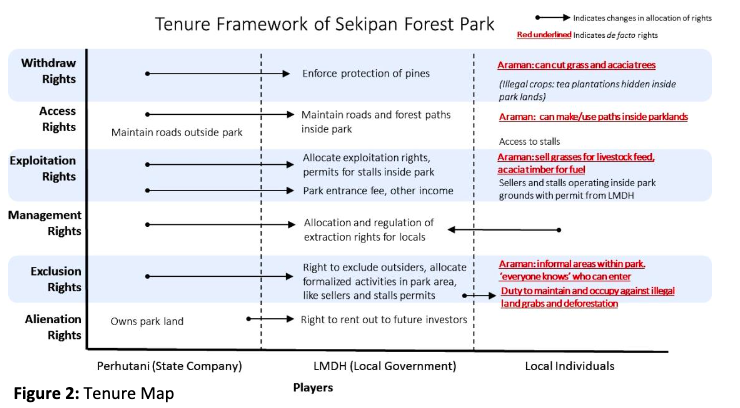To See Invisible Rights: Quantifying Araman informal tenure and its immediate relationship with Social Forestry in Central Java, Indonesia
Versions
- 2019-06-25 (2)
- 2019-06-25 (1)

The process of formalizing traditional, unwritten tenure systems is no simple task. Inaccurate or incomplete representation of the informal system may create more problems for the local communities. As such, a full understanding of the local informal tenure systems is necessary before implementing any type of land reform. This paper discusses a case study conducted in the Tawanmangu area of Central Java, Indonesia, in which the informal system known as Araman is quantified on paper with the help of the Tenure Map tool, survey, and interview. The challenges of quantifying and understanding an informal system are discussed with the following viewpoints: key aspects of the Araman structure, the relationship between the informal Araman system and the formal Social Forestry system also present in the area, and finally comments on the strengths and weaknesses of the Tenure Map tool after using it in the field.
Banjade, M. R., Liswanti, N., Herawati, T., Mwangi, E. (2017). Outcomes of land and forest tenure reform implementation in Indonesia. World Bank Conference on Land and Poverty, Washington DC, March 20-24, 2017.
Barry, D., Meinzen-Dick, R. (2010). The invisible Map: Community Tenure Rights. Book: The Social Life of Forests, University of Chicago Press
Chao, S. (2012). Forest Peoples: Numbers across the world. UK: Forest Peoples Program. http://www.forestpeoples.org/sites/fpp/files/publication/2012/05/forest-peoples-numbers-across-world-final_0.pdf
Mahdi, Shivakoti, G., Inoue, M. (2017). Decentralization of Forest Management, Local Institutional Capacity, and Its Effect on Access of Local People to Forest Resources: The case of West Sumatra, Indonesia. In Redefining Diversity & Dynamics of Natural Resources Management in Asia, Volume 1 (pp. 305-319). doi: https://doi.org/10.1016/B978-0-12-805454-3.00016-5
Maryudi, A., Citraningtyas, E. R., Purwanto, R. H., Sadono, R., Suryanto, P., Riyanto, S., & Siswoko, B. D. (2016). The emerging power of peasant farmers in the tenurial conflicts over the uses of state forestland in Central Java, Indonesia. Forest Policy and Economics, 67, 70-75. doi: https://doi.org/10.1016/j.forpol.2015.09.005
MOEF. (2017). Social Forestry in Indonesia [Brochure]. Indonesia.
Moeliono, M., Thuy, P., Waty Bong, I., Wong, G., & Brockhaus, M. (2017). Social Forestry - why and for whom? A comparison of policies in Vietnam and Indonesia. Forest and Society, 1(2), 78-97. doi: http://dx.doi.org/10.24259/fs.v1i2.2484
Schlager, E., & Ostrom, E. (1992). Property-rights regimes and natural resources: a conceptual analysis. Land economics, 249-262. doi: http://dx.doi.org/10.2307/3146375
Siscawati, M., Banjade, M. R., Liswanti, N., Herawati, T., Mwangi, E., Wulandari, C., Tjoa, M., & Silaya, T. (2017). Overview of forest tenure reforms in Indonesia (Vol. 223). CIFOR.
The World Bank. (2017). Brief: Land. Retrieved from http://www.worldbank.org/en/topic/sustainabledevelopment/brief/land.
Van Der Eng, P. (2016). After 200 years, why is Indonesia’s cadastral system still incomplete? Canberra, Australia: Australian National University.
Van Vliet, J., Magliocca, N. R., Büchner, B., Cook, E., Benayas, J. M. R., Ellis, E. C., ... & Mertz, O. (2016). Meta-studies in land use science: Current coverage and prospects. Ambio, 45(1), 15-28. doi:https://doi.org/10.1007/s1328
Copyright (c) 2019 Forest and Society

This work is licensed under a Creative Commons Attribution 4.0 International License.
This is an open access journal which means that all contents is freely available without charge to the user or his/her institution. Users are allowed to read, download, copy, distribute, print, search, or link to the full texts of the articles in this journal without asking prior permission from the publisher or the author. This is in accordance with the BOAI definition of open access.
Submission of an article implies that the work described has not been published previously (except in the form of an abstract or as part of a published lecture or academic thesis), that it is not under consideration for publication elsewhere, that its publication is approved by all authors and tacitly or explicitly by the responsible authorities where the work was carried out, and that, if accepted, will not be published elsewhere in the same form, in English or in any other language, without the written consent of the Publisher. An article based on a section from a completed graduate dissertation may be published in Forest and Society, but only if this is allowed by author's(s') university rules. The Editors reserve the right to edit or otherwise alter all contributions, but authors will receive proofs for approval before publication.
Forest and Society operates a CC-BY 4.0 © license for journal papers. Copyright remains with the author, but Forest and Society is licensed to publish the paper, and the author agrees to make the article available with the CC-BY 4.0 license. Reproduction as another journal article in whole or in part would be plagiarism. Forest and Society reserves all rights except those granted in this copyright notice







